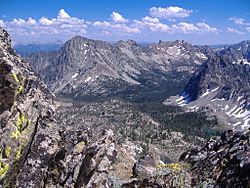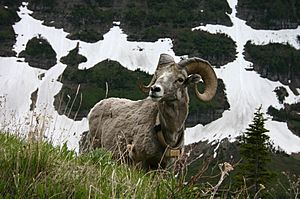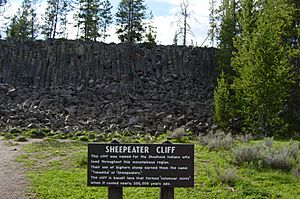Tukudeka facts for kids

Sawtooth Range, the traditional home of the Tukudeka in central Idaho
|
|
| Total population | |
|---|---|
| Fewer than 5,822 | |
| Regions with significant populations | |
| Languages | |
| Shoshone, English | |
| Religion | |
| Native American Church, Sun Dance, traditional tribal religion, Christianity, Ghost Dance |
|
| Related ethnic groups | |
| Other Shoshone tribes, Bannock, Northern Paiute |
The Tukudeka are also known as the Mountain Sheepeaters. They are a group of Shoshone people. Long ago, they lived in the mountains of central Idaho and northwest Wyoming. This was before they lived on reservations.
Tukudeka groups often moved around and connected with other Shoshone bands. Today, many Tukudeka are part of the Shoshone-Bannock Tribes in Idaho. Others are part of the Eastern Shoshone on the Wind River Indian Reservation in Wyoming.
Contents
What's in a Name?

The name "Tukudeka" can be spelled in different ways. Some spellings include Tukadüka or Tukudika. It means "Eaters of White Meat" or "Eaters of Mountain Sheep." This is why they are also called "Sheepeaters."
They got their name because they often hunted Bighorn sheep (Ovis canadensis). The Shoshone word for bighorn ram is "duku." This word also means "meat." So, their name might also mean "eaters of meat." They are sometimes called Mountain Shoshone or Toyahini, which means "mountaineers."
Speaking the Shoshone Language
The Tukudeka people speak the Shoshone language. They also speak English. Shoshone is a Central Numic language. It belongs to the larger Uto-Aztecan language family.
A Look at Tukudeka History

The Tukudeka's traditional lands were near the Salmon River in the Sawtooth Mountains. They also lived in southern Montana and Yellowstone in Wyoming.
The first Europeans came to their lands in 1824. American and British trappers hunted beavers there in the 1840s. In 1860, gold was found, and many non-native people moved into the area.
In the 1860s, officials estimated there were about 1,200 Tukudeka and Lemhi Shoshone people.
In 1879, five Chinese miners were killed near Loon Creek. Even though there was no proof, the Tukudeka were blamed. The US Cavalry then attacked the tribe in what was called the Sheepeater War. Fifty-one Tukudeka were captured. They were then moved to the Fort Hall Reservation.
Amazing Tukudeka Inventions
The Tukudeka people were very clever. They are known for three special inventions. These include a unique cooking pot, a way to trap bighorn sheep, and a powerful bow.
Cooking with Soapstone Pots
In the mountains of Wyoming, the Tukudeka used cooking pots made from soft soapstone. These pots could hold a lot of liquid, about a gallon. They could be placed right into a fire. Soapstone holds heat very well. This meant the pot could stay hot and keep water boiling for a long time after being taken out of the fire. Places where the Tukudeka dug for soapstone have been found.
Clever Sheep Traps
The Tukudeka knew a lot about bighorn sheep. They built special traps called corral traps. These traps were shaped like a spiral, similar to a bighorn sheep's horn. The opening of the trap faced downhill.
Hunters would approach the sheep from above and scare them downhill. Sheep naturally try to run uphill to safety. This movement would guide them into the trap, which was usually made of logs. Hunters would then scare the sheep further into the narrow part of the spiral. A special leader would help guide the sheep. At the end of the trap, the sheep would run up a ramp into a raised area with wide gaps. Their feet would fall through, making them unable to move. Hunters could then safely take the sheep using clubs or spears. Some of these traps were used into the 1800s. Their remains could still be seen in the late 1900s. The Tukudeka also hunted sheep by guiding them into deep spring snowdrifts.
Powerful Sheephorn Bows
Shoshone people living where bighorn sheep were found made special bows from sheep horns. This process took two to three months. They would boil and straighten the spiral horn of a bighorn sheep. They might have used hot springs in geothermal areas to heat the horns. The horn was shaped over time and strengthened with sinew.
These bows were shorter than wooden bows but much stronger. They could have a pull strength of up to 70 pounds! This made them very powerful. Sheephorn bows were valuable for trading. They could be traded for five to ten horses. This bow is one of the strongest bows made by native people in North America.

